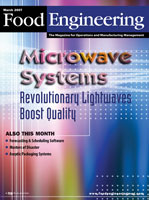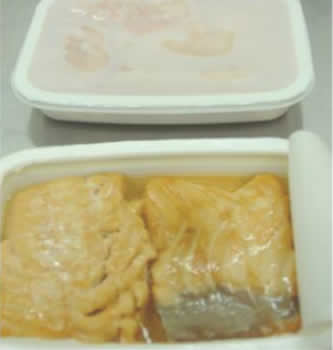News
Below is a compilation of news articles and links to showcase the reach, scope and importance of our research.
2016
"Kiwi college investigates 'game-changing' technology", Food Navigator-Asia. com. 2016.
"Massey investigating novel food technology", Scoop News. 2016.
"Feeling the heat", International Innovation. 2016.
2015
"Microwave Inches Toward Mainstream", Food Processing. March 2015, 57-63.
2014
"Minimum Heat Processing & Packaging with Microwaves", Food Technology Magazine. December 2014, Volume 68, No. 12.
"Tastier food for soldiers with MATS technology", Food Processing (Australia). November 2014.
2013
"Microwave Sterilization for Packaged Meals", Food Engineering Magazine. October 2013, 159-160.
"Electromagnetic Energy in Food Processing", Food Technology Magazine. April 2013, Volume 67, No. 4.
2012
"Secret Ingredients, Seattle Business 2012 23(11):47-49.
"Juming Tang receives the ASABE Society's International Food Engineering Award for 2012", www.asabe.org.
"AmeriQual involved in 'game-changer' food processing research", Evansville Courier & Press (September 10, 2012).
"Microwave Sterilization System Rolled Out in the US", Food Production Daily.com. (September 3, 2012)
"The Coming Wave of Microwave Sterilization and Pasteurization", Food Technology Magazine. March 2012, Volume 66, No. 3.
2011
"Packaging Innovation-Past, Present, and Future"; Food Technology, December 2011; Volume 65, No.12
"Moisture-absorbing microwave Packaging will boost industry standard -developer", FoodProduction Daily; December 7, 2011 features a new packaging material, NorAborbit, developed by Nordenia International.
"Advances in Microwave Pasteurization and Sterilization" presents history, problems encountered, advances, and successes in this exciting field of research; February 2011 issue of IFT Food-Technology
Wornick Foods Awarded Ohio Third Frontier Grant for Commercialization of MATS. (June 14, 2011)
Wornick Foods Launches Microwave Sterilization Initiative. (March 8, 2011)
WSU Microwave Technology Earns Second FDA Approval. (February 8, 2011)
February 2011 issue of IFT Food-Technology "Advances in Microwave Pasteurization and Sterilization" presents history, problems encountered, advances, and successes in this exciting field of research.
Spectacular Wins for Food Packaging (.pdf)
Food Technology Magazine. September 2010, Volume 64, No.9.
2010
STARS Quarterly reports that WSU has successfully started up a new Washington-based company, Food Chain Safety, to commercialize Dr Juming Tang's Microwave Sterilization Technology for use in the Food Processing Industry. (July, 2010).
2010 IFT Achievement Award to WSU Microwave Sterilization Consortium
IFT Live. July 27 2010.
Research and Development Award: C. Patrick Dunne, Douglas Hahn, Kenny Lum, Juming Tang, and Evan Turek, representing the Washington State University Microwave Sterilization Consortium. $3,000 honorarium and a plaque from IFT.

Five representatives of the Washington State University Microwave Sterilization Consortium, Juming Tang, project lead, Washington State University; C. Patrick Dunne, U.S. Army Natick Soldier Research Development and Engineering Center; Douglas Hahn from Hormel Foods Corp.; Kenny Lum from Seafood Products Association; and Evan Turek from Kraft Foods Inc., received the 2010 IFT Research and Development Award for their contributions to food technology that result in foods of improved quality and nutrition.
The consortium also includes The Ferrite Company, Rexam PLC, Graphic Packaging and Ocean Beauty Seafoods, LLC.
The team represents a collaborative effort of academia, industry, and the U.S. Army to develop a microwave sterilization process for pre-packaged, low-acid foods that was acceptedby the U.S. Food and Drug Administration as of October 2009. More than 40 research scientists, engineers, and graduate students participated in different phases of the research since the consortium was formed ten years ago with financial support from the Department of Defense Dual Use Science and Technology Program and contributions from food industry partners.Through the development of a semi-continuous, single-mode, 915 MHz microwave system, the sterilization process was dramatically shortened thereby providing significant improvements to food quality.
US FDA Approved first Microwave Sterilization Process Developed At Washington State University
International Journal of Agricultural and Biological Engineering. Vol 3(2) 2010.
New Microwave Could Replace Canning
The Daily Evergreen. By Andrew Marron. March 23 2010.
Microwave Sterilization May Revolutionise Food Processing
By Rory Harrington, February 23 2010.
Engineering R&D: Move over, retort
Food Engineering Magazine, February 1 2010. By Kevin T. Higgins, Senior Editor.
2009
FDA Approves Microwave Preservation Process for Prepared Foods
Northwest Public Radio, October 29 2009.
Revolutionary technology: FDA RA Approves Microwave Preservation Process for Prepared Foods
By Kathy Barnard, College of Agricultural, Human and Natural Resource Sciences. WSU Today online, October 29 2009.
PULLMAN - Imagine a salmon filet that looks, tastes and is as nutritious as freshly cooked salmon but has a shelf-life of more than six months. A new technology developed at WSU will make that a reality and could revolutionize how we preserve and process food.
For the first time, the U.S. Food and Drug Administration has approved the use of microwave energy for producing pre-packaged, low-acid foods, a major milestone that clears the way for its commercialization.
Juming Tang, a professor in the Department of Biological Systems Engineering, led a team of university, industry and U.S. military scientists to develop the technology. The outcome results in food with a longer shelf life as well as better flavor and nutritional value compared to more traditional food-processing methods such as canning.
“New processes for producing shelf-stable, low-acid foods must pass rigorous reviews by FDA to ensure that the technology is scientifically sound and the products will be safe,” Tang said. “Our team patented system designs in October 2006 after more than 10 years of research. We spent another three years developing a semi-continuous system, collecting engineering data and microbiologically validating the process before receiving FDA acceptance.”
The team’s microwave sterilization process technology immerses the packaged food in pressurized hot water while simultaneously heating it with microwaves at a frequency of 915 MHz - a frequency that penetrates food more deeply than the 2450 MHz used in home microwave ovens. This combination eliminates food pathogens and spoilage microorganisms in five to eight minutes and produces safe foods with much higher quality than conventionally processed ready-to-eat products.
Spearheaded by C. Patrick Dunne, Department of Defense combat feeding directorate at the U.S. Army Soldier Systems Center at Natick, Mass., the project has been funded from a variety of sources and a consortium of industry members that include Kraft Foods, Hormel, Ocean Beauty Seafoods, Rexam Containers, Ferrite Components and Graphic Packaging. The WSU team also worked closely with process authorities of the Seafood Products Association in Seattle and Hormel to establish validation procedures and in preparation of filing documents. In addition, faculty members from other WSU departments, particularly Food Science, contributed to the project.
“The team’s collective efforts have brought a new food processing technology to the forefront that will truly benefit not only the commercial sector but our war-fighters worldwide with a wider variety of high quality, shelf-stable foods,” said Gerald Darsch, director of the U.S. Department of Defense Combat Feeding team. “It is truly a tremendous accomplishment.”
Evan Turek, senior research fellow at Kraft Foods, said Tang’s new technology will make a huge difference for the food industry.
“Since the introduction of industrial microwave ovens in the late 1940s, the food industry has been interested in exploiting the rapid heating capability of microwaves to improve the quality of canned food,” he said. “The technical issue has always been ensuring uniform and reproducible heat treatment.
“Dr. Tang had a vision about how this might be overcome, and with his leadership and the engineering prowess of his research staff and students, a protocol for practicing and validating microwave sterilization was established,” Turek said. “Kraft Foods is proud to have been an early supporter of the research program at WSU and looks forward to the commercialization of the technology.”
WSU officials agreed.
“This is a great example of how research universities like Washington State University produce breakthroughs that make an immediate impact on our nation and world. This new technology promises significant advances in food safety and quality to benefit everyone,” said Howard Grimes, vice president for research.
Dan Bernardo, dean of the WSU College of Agricultural, Human and Natural Resource Sciences, said the impact of the science will be dramatic.
“There have been very few advances leading to FDA-accepted food processing technologies in recent history,” he said. “The FDA’s approval of this new technology truly could revolutionize the way we process and preserve food, ensuring food safety, increasing its longevity and maximizing the retention of its flavor and nutrition.”
Ralph Cavalieri, director of the WSU Agricultural Research Center, said Tang’s research has global benefits.
“It is important across a range of applications,” he said, “from feeding astronauts on long-term space missions or soldiers in the field to transporting and storing food to areas of the world where people are unable to produce enough food locally to feed themselves.”
Cavalieri said the project would not have been possible without support from a variety of sectors.
“We have worked synchronously with industry, the army and the university to make this happen,” he said. “Dr. Tang’s research also has received incredible support from Washington’s Congressional delegation, especially Sen. Patty Murray.”
Murray said ensuring funding for projects such as Tang’s is part of an overall effort to support Washington’s agricultural and food industry in ways that benefit the nation and world.
“This is great news for WSU, our growers and American food processors,” she said. “It will help our growers and processors stay more competitive in the global marketplace and increase food safety for consumers.”
Less energy usage is claimed for novel pasteurisation process
Food Production daily.com Mar 20 2009.
A new way of sterilizing packaged foods that offers rapid results and less energy consumption has been the focus of a recent project undertaken by the German research group, the Fraunhofer Institute for Process Engineering and Packaging.

NCFST Receives Regulatory Acceptance of Novel Food Sterilization Process
Chicago, Feb. 26, 2009.
The National Center for Food Safety and Technology (NCFST), Illinois Institute of Technology (IIT) and Avure Technologies, Inc., announced today that the U.S. Food and Drug Administration (FDA) has accepted the research institute’s filing of a new food sterilization process. The NCFST filing is the first ever petition to FDA for the commercial use of pressure-assisted thermal sterilization (PATS) processes for application in the production of low acid foods.
2007
Beijing to use mobile microwave heating tunnels as a food safety measure for 2008 Olympic Games
China Gate. July 20 2007.

Changing demands driving evolution of food factories
Foodproductiondaily.com:Europe. April 19 2007.
The food factory of the future will be smaller than the massive production plants of today, with more automation and the flexibility to switch to new products at the push of a button.
This was the vision held up yesterday by Thomas Ohlsson at a conference in Brussels examining the future research needs of the food industry.

Microwave Systems: Revolutionary Lightwaves Boost Quality
Food Engineering: The Magazine for Operations and Manufacturing Management. March 1, 2007.
Signal variability has blocked widespread use of microwavetechnology in food processing. That is about to change.
Electromagnetic radiation still is a new and exotic option in food and beverage processing, though it gradually is finding niches in various applications as research engineers overcome the practical barriers to commercial use.
2004
Salmon May Be Getting a New Wrap
http://www.seattlepi.com. April 24, 2004

With a few phone calls and e-mails, Ketchikan fisherman Johnny Rice may have helped Alaska's wild salmon out of the metal can and into a new niche market.
Researchers in Washington state say they are close to perfecting a new method of microwaving food that not only gives salmon a grocery-store shelf life but delivers a fillet of restaurant-quality straight from a pouch -- no refrigeration necessary.
Active & Intellegent Pack News
http://www.piranet.com. April 14, 2004
Food brand owner Heinz has dropped a unique retortable packaging featuring susceptor film technology developed by Alert Packaging.
Until two months ago Heinz had sole rights to use Alert's Micro-Crisp film, a specialty substrate for retortable packaging applications. But Heinz recently made the decision to de-list the product range that used the film, opening up a raft of opportunities for other brand owners.
Sen. Murkowski Announces New Salmon Processing Breakthrough
http://www.AlaskaReport.com. March 19, 2004.
Senator Lisa Murkowski announced a breakthrough in the processing of packaged salmon that may increase demand for salmon and help improve prices for Alaska's wild salmon stocks.
Microwaves Improve Processed Food Quality
http://www.natick.army.mil. March 4, 2004.
Microwave energy, long used in homes to cook or reheat food, is gaining momentum in the United States as a method for processing more palatable shelf-stable foods for the military and commercial market.
Already successfully used overseas as an alternative to frozen or refrigerated packaged foods, a partnership between the Department of Defense Combat Feeding Directorate at the Soldier Systems Center in Natick, Mass.; Washington State University (WSU) in Pullman, Wash.; and several food processing, equipment and packaging companies to process food through a microwave sterilization system is moving ahead with a fresh influx of federal and private sector funding.
Microwave sterilization kills bacteria while retaining high quality
http://www.natick.army.mil/about/pao/pubs/warrior/04/marapr/index.htm
Microwave energy, long used in homes to cook or reheat food, is gaining momentum in the United States as a method for processing more palatable shelf-stable foods for the military and commercial market.
Already successfully used overseas as an alternative to frozen or refrigerated packaged foods, a partnership between the Department of Defense Combat Feeding Directorate at the Soldier Systems Center in Natick, Mass.; Washington State University (WSU) in Pullman, Wash.; and several food processing, equipment and packaging companies to process food through a microwave sterilization system is moving ahead with a fresh influx of federal and private sector funding.

